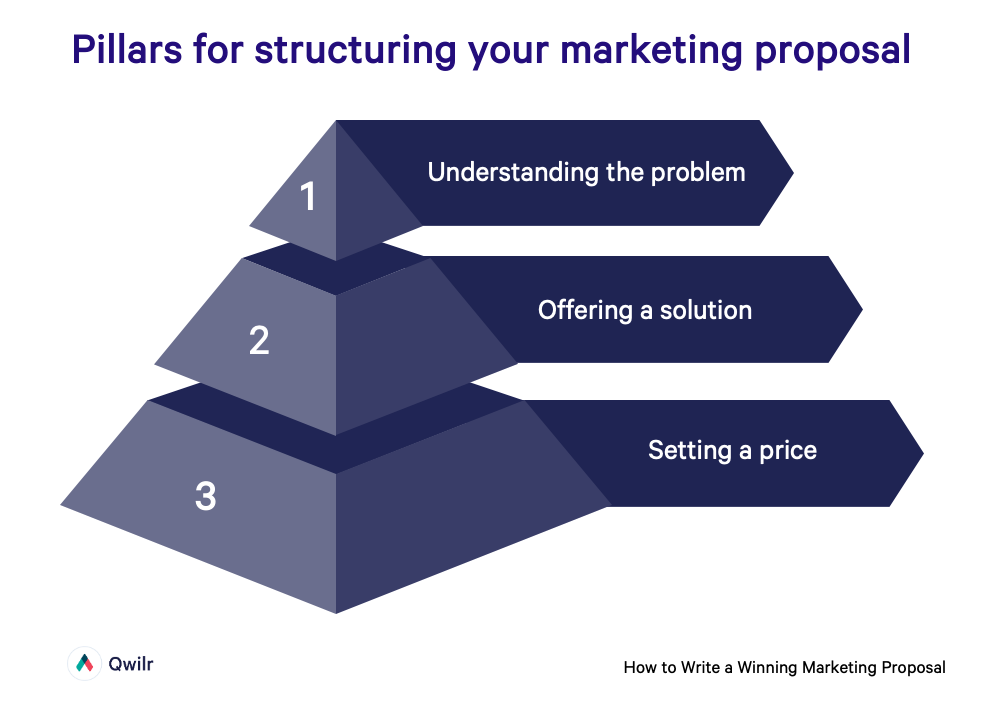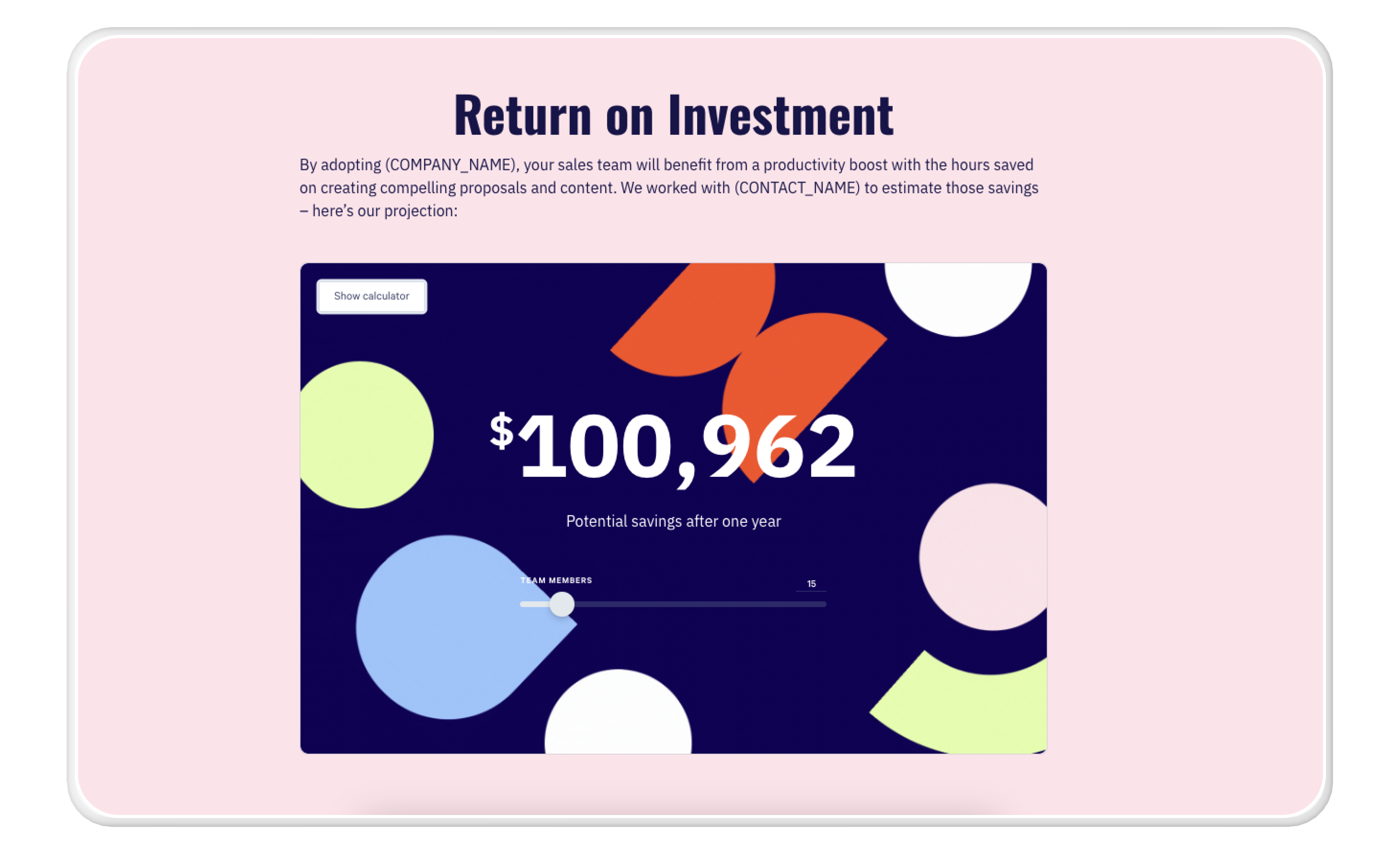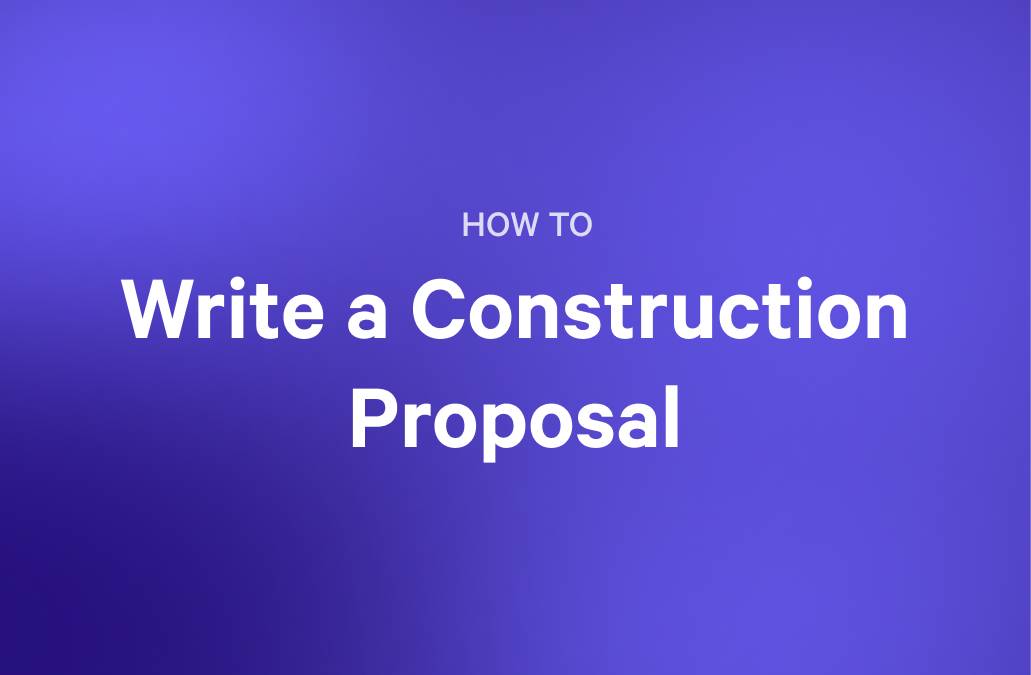A well-crafted marketing proposal is more than just a document; it's a strategic tool that can take your business to new heights. The right proposal is the master key, opening doors to exciting and profitable new clients and projects.
In this guide, we're going to simplify things. We'll break down what makes a marketing proposal not just good, but great. We'll also show you how to avoid the common mistakes that can turn your deal-maker into a deal-breaker, giving you the knowledge needed to create a proposal that stands out.
Ready to learn how to write a marketing proposal that always gets a 'yes'?
What is a marketing proposal?
In a marketing proposal, you outline how your marketing services can help prospective clients achieve their goals. A customized conversation on paper that says: "We know what you need and how we can help you."
In the business world, a good marketing proposal is crucial. It's not just about selling your services; it's about starting a lasting relationship. A well-crafted marketing proposal shows that you understand your client's challenges and have a marketing strategy that can make a real difference.
It’s the first step in turning your prospect into a partner and sets the tone for the relationship that follows.
The importance of understanding client needs
Understanding your client's needs is the cornerstone of a compelling marketing proposal. It's about doing your homework. This means going beyond a superficial Google search and delving deep into your client's industry to understand their challenges and find out exactly what they want to achieve.
By comprehensively understanding your client’s goals, whether it's increasing brand awareness, boosting sales, or entering new markets, you can tailor your sales proposal to offer solutions that resonate with their vision and objectives.
When you understand your client's world and specific pain points, your proposal no longer becomes just a pitch but a customized solution. That's the difference between "This is what we do" and "This is how we can solve your problem.”
So, when you write your proposal, remember it's not only about what you're offering. It's about how your offer matches what your customer really needs. This understanding turns a good offer into a great one.
Structuring your marketing proposal
Drafting your marketing proposal is like laying a clear path for your client. A solid proposal rests on three pillars: understanding the problem, offering a solution, and setting a price that aligns.

Problem statement
After your cover page or executive summary makes a good first impression, you have your problem statement. This is where you show that you understand what they're facing and closely examine the specific challenge. Instead of making a blanket statement that applies to everyone, you address their unique situation.
For instance, if you're working with a small eco-friendly clothing brand, don't just say, "Many brands struggle with online visibility." Get specific. Try something like, "As a growing eco-conscious clothing brand, you're competing in a digital space crowded with fast fashion giants, making it difficult to reach your eco-conscious audience.”
This targeted approach does two things: it makes your client feel understood, and it sets the stage for your customized solution.
Proposed solution
Now, you need to tailor your services to the customer's problem. This is where you connect their challenge with your expertise and present a clear, customized action plan.
Instead of offering a general solution like "We improve your digital marketing," you should be specific with the scope of work. You could say, "We're developing a targeted social media strategy highlighting your eco-friendly values and appealing to consumers passionate about sustainable fashion. We're also using social media marketing, Search Engine Optimization, and content marketing to increase your visibility online and ensure your target audience sees you.”
In this section, you also want to share the metrics you’ll use to quantify your success, providing a time frame and milestones for your deliverables.
This approach is not just about listing services. It helps your clients recognize how your specific plan can take them from where they are now to where they want to be.
Pricing information
Your pricing should be upfront and as transparent as the rest of your proposal. Not only will this help your customers see exactly what they are paying for, but it will also help you build trust to take into the relationship moving forward. Present your pricing model to emphasize the value and return on investment the client can expect.
Then, conclude with a compelling call to action. This could be an invitation to a meeting, a request for stakeholder feedback, or a prompt for the next steps. The structure should flow logically, leading the client through a journey from identifying a problem to seeing your service as the solution.
Tailoring your solution
Tailoring your solution to meet each client's unique needs is a critical aspect of a winning marketing proposal. This customization involves more than just rehashing a standard service offering; it requires a deep dive into the client's business needs.
Conduct thorough market research and competitor analysis to understand the client's industry landscape. Use this insight to adapt your services to the client's unique context and marketing goals.
For instance, your proposal might emphasize differentiation strategies if the client operates in a highly competitive market like SaaS. If they are a new player, focus on market penetration and brand awareness. The key is to show that you understand their needs, the environment in which they operate, and how your services can be uniquely positioned to help them succeed.
Showcasing your unique value proposition
In a crowded market, your unique value proposition (UVP) is the key differentiator in your marketing proposal. It’s not just about what you offer or being budget-friendly, but how what you offer brings unique value to the table. Answering the client’s implicit question: “Why should I choose you?”
Here are some ways to effectively showcase yours:
1. Highlight specific expertise: If you have specialized expertise or certifications relevant to the client’s industry, highlight them. This could be expertise in a specific marketing channel (like social media or SEO) or experience in a niche market. This is an excellent place to pull in some case studies for additional social proof (more on that below).
2. Customization and flexibility: Emphasize the customizability of your solutions. Show how you can adapt your strategies to meet not just the current needs of the client but also their future growth and evolution.
3. Innovative approaches: If your methods include innovative technologies or cutting-edge strategies, detail these. For example, if you use AI-driven analytics to drive marketing decisions or have a unique approach to content creation, these are points worth highlighting.
4. Case studies and success stories: Nothing speaks louder than results. Include brief case studies or success stories of other marketing projects demonstrating how your unique approach has driven success, especially if those clients faced similar challenges or operated in similar markets.
5. Testimonials and endorsements: Incorporate testimonials from previous clients, especially those that speak to the unique aspects of your service. An endorsement from a well-known client can significantly boost your proposal’s credibility. Remember to ask permission from clients to use them as an endorsement or reference for potential new clients.
6. Value beyond services: Discuss the additional value you bring, such as ongoing support, detailed analytics reports, or training sessions for the client’s team. This shows you’re invested in their long-term success, not just the immediate project.
7. Competitive analysis: Briefly and without disparaging others, show how your offerings stack up against typical competitors in key areas like pricing, service scope, and results. This helps to contextualize your UVP in the market landscape.
By expanding on these areas in your marketing proposal, you can effectively communicate why your services are not just different but better and more aligned with the client’s specific needs and goals.
Enhancing your marketing proposal
Today's world is digital, and your proposal should reflect that. Adding elements like a video can make your pitch stand out from other marketing agencies. When you're putting together your marketing plan, consider how these visual and digital enhancements can present your proposal in a way that's informative, captivating, and forward-thinking.
The role of video in proposals
A video walkthrough isn't just a fancy addition; it's a practical tool that provides clarity and builds trust.
Videos can:
- Add a personal touch- your prospects get to see and hear from your team, which can create a stronger bond.
- Enable you to showcase your team's energy and expertise in a way that text alone can’t.
- Allow you to openly explain your methods and how you intend to achieve results, helping your clients feel more confident about working with you.
Including a video in your proposal transforms it from a simple document to an engaging presentation, making your offer more appealing to your clients and their decision-makers.
Speak the language of money with an ROI calculator
Embedding an ROI (Return on Investment) calculator can make your proposal stand out, allowing you to show the financial benefits of your services in clear, tangible terms.
Let's assume you've had a detailed discussion with your customer about their goals. You can use an ROI calculator to convert this information into actual financial impact. For example, if your proposal is for a new marketing campaign or new marketing channels, the calculator can show how these elements can increase sales or reduce costs. This gives your customer a clear overview of the potential financial benefits of investing in your proposed solution.
Not sure how to make an ROI calculator? Here’s a great example in a Qwilr proposal template!
Including an ROI calculator in your proposal does two essential things:
- It makes your proposal more interactive and engaging.
- It strengthens your proposal by backing up your claims with data.

Interactive elements
Consider including interactive elements such as clickable menus or expandable sections. These features can make your proposal more engaging but still user-friendly. For example, a clickable table of contents allows customers to easily navigate the sections that interest them the most.
Custom graphics and infographics
Use customized graphics and infographics to break up text and present information in a visually appealing way. Complex data or processes can be simplified and easily digested with well-designed infographics.
Testimonials and case studies
Testimonials or brief case studies from past clients can significantly increase the credibility of your proposal. They show potential clients real-life examples of your success and the value you have provided to others.
Qwilr’s content tools and templates help you create branded, visually arresting pages in a fraction of the time, giving your clients all the information they need to understand your value and drive decisions while delivering a great buyer experience. These tools can be leveraged to format testimonials and add polished and professional-looking images and headshots, elevating this section of your proposal.
How to follow up after sending your marketing proposal
Once your marketing proposal is out the door, the next crucial step is following up. A well-timed follow-up can keep the conversation going and show your prospective client that you're proactive and attentive.
Check out the video below for insights on how to effectively follow up after sending your proposal:
Remember, the goal of your follow-up is not just to remind the client about your proposal but to demonstrate your commitment to their success and your eagerness to start working together.
Avoiding common pitfalls
Okay, now we’ve covered the benefits and best practices, let us prepare you more fully by acknowledging the potential stumbling blocks. This can help shorten your learning curve when it comes to creating or improving your marketing proposals.
Losing client interest
Between 40-60% of deals end up lost due to customer indecision, and many of these can be chalked up to the client simply losing interest. This usually happens when the content is too dense, generic, or irrelevant to the client's needs.
To avoid this, your proposal should be focused, appealing, and tailored to the customer's specific challenges and goals. See how this article breaks up what could be a dense 2500-word block into clear headings, concise language, and bullet points? That wasn’t an accident. It makes the article much easier to read and less daunting for the modern reader. Follow suit and ensure you break up the text in your proposals with visuals or bullet points.
Too much focus on the service provider
While showcasing your strengths is important, it's a common mistake to over-emphasize your business instead of addressing the client's needs. Your offer should put the client’s business front and center. Instead of leading with what you offer, you should start with the customer's needs and how to fulfill them. You’ll get plenty of chance to toot your own horn later on.
Overcomplicating the solution
Complex jargon or overly technical explanations can confuse clients, leading them to disengage. Your solution should be straightforward. Clarity is critical. Clients who can't grasp what you're offering won't be convinced of its value and will be unlikely to move forward with your proposal.
Lack of clear objectives
Proposals that don't have clear, measurable objectives can appear vague and unconvincing. Ensure your proposal includes specific goals and how you plan to achieve them. This shows you have a clear vision and strategy.
Neglecting the follow-up
Not mentioning how and when you will follow up after sending the proposal can leave things hanging. Indicate a specific time when you will reach out to discuss the proposal further. This shows initiative and keeps the momentum going.
Ignoring the competition
Not acknowledging the competitive landscape can make your proposal seem naive and short-sighted. Show that you understand where your client stands among competitors and how your solution can help them stand out.
Marketing proposal template
Using a marketing proposal template ensures every offer you send out is highly professional and consistent with your brand. With a template, you spend less time on layout and design and more on tailoring content to each client's needs. This efficiency saves time and helps you maintain a high standard with every quote.

Qwilr’s marketing proposal templates combine functionality with aesthetic appeal. The templates are easy to use and customize, with a visual appeal that presents your company in the best light with every pitch.
Stepping up your own marketing proposals
We’ve spent some time reviewing some best practices to include and some common pitfalls to avoid when writing marketing proposals, so before we turn you loose and let you get back to creating your own proposals, let's highlight the key ingredients for success:
- Understand your client's needs
- Clearly state the problem
- Offer a tailored solution.
Be clear and concise, ensuring your proposal speaks directly to the client's goals, and don’t forget to add a personal touch and show your unique value. You can even include a bit of personality and some flavor to show what it will be like to work with you and your team on a regular basis.
Now, take these tips to help craft yourself a compelling marketing proposal. And, if you want to save a chunk of time and guarantee you knock it out of the park, we know someone who can help… (hint, hint, it’s us!)
About the author

Marissa Taffer|Founder & President of M. Taffer Consulting
Marissa Taffer is the Founder & President of M. Taffer Consulting. She brings over 15 years of sales and marketing experience across various industries to a broad range of clients.
FAQs
Every marketing proposal should have an executive summary, a clear problem statement, and a tailored solution that aligns with the client's needs. These should be followed with detailed pricing information and a clear call to action. It's all about showing how you can help clients achieve their goals clearly and confidently.
The amount of time it takes to write a winning marketing or business proposal, varies based on a number of factors including the complexity of the client’s needs and your solution. As a benchmark, it generally takes anywhere from a few hours to a few weeks. You should balance being thorough and efficient, focusing on quality and clarity to address the client's needs and goals. (Of course, a marketing proposal template can speed the process up considerably…)
Absolutely! Backing up your proposal with data and research shows that you have done your homework and adds credibility to your recommendations. Use data to reinforce your understanding of the client's problems and justify your proposed solutions.


